Master Arrowroot Powder in Baking
Welcome to your guide to arrowroot powder in baking! In this comprehensive journey, you’ll explore everything from the origins of this versatile ingredient to its various applications and benefits in baking. Whether you’re looking to improve the texture of your gluten-free treats or need a reliable thickening agent, arrowroot powder has you covered. So, let’s dive in and discover the wonders of arrowroot powder!
Introduction to Arrowroot Powder
Introduction:
Arrowroot powder is a starchy, gluten-free flour extracted from the tuberous roots of the arrowroot plant (Maranta arundinacea). Often used in baking, this ingredient has grown in popularity as a natural and healthy alternative to cornstarch or wheat flour. In this guide, you will learn about arrowroot powder, its origin, and how it is sourced – helping you confidently incorporate it into your baking endeavors.
Origin of Arrowroot:
- Arrowroot is a perennial herb native to the tropical rainforests of Central and South America, particularly in countries such as Brazil and Guyana.
- The plant is known for its large, starchy tubers, which have been a staple food for many indigenous communities for centuries.
- The name ‘arrowroot’ traces back to the Arawak people, who used the starch to treat arrow wounds or as an antidote for poison.
How Arrowroot Powder is Sourced:
-
Harvesting:
- Arrowroot plants are usually ready for harvest 8-12 months after planting, when the tubers have reached their peak size and starch content.
- Farmers carefully dig up the tubers, taking care not to damage them, and remove the thin outer skin.
-
Processing:
- The tubers are first washed thoroughly to eliminate impurities and soil.
- They are then grated or mashed to extract the starchy liquid which is collected and strained.
- The liquid is allowed to settle, and the excess water is drained, leaving behind a thick, starchy residue.
-
Drying and Milling:
- The starch is spread out on large, flat surfaces and allowed to air dry.
- The dried starch is then ground into a fine, white powder – this is the arrowroot powder that makes its way into grocery stores and ultimately, your kitchen.
Benefits and Applications in Baking:
- Gluten-free: Arrowroot powder is completely gluten-free, making it suitable for those with celiac disease or gluten sensitivities.
- Thickening agent: It can be used as a thickener for sauces, puddings, and pie fillings, providing a smooth, glossy consistency without a noticeable taste.
- Binding and texture: In baking, it is often used as a binding agent and can help provide a lighter texture in cakes and cookies.
- Digestibility: Arrowroot is known for being easily digestible, making it a gentle option for those with sensitive stomachs.
Conclusion:
Now that you have a better understanding of arrowroot powder, its origin, and how it is sourced, you can confidently include it in your baking recipes. As a versatile and healthy alternative to other thickeners or flours, arrowroot powder is a great tool for those seeking gluten-free, easily digestible, and natural options in their culinary creations. Happy baking!
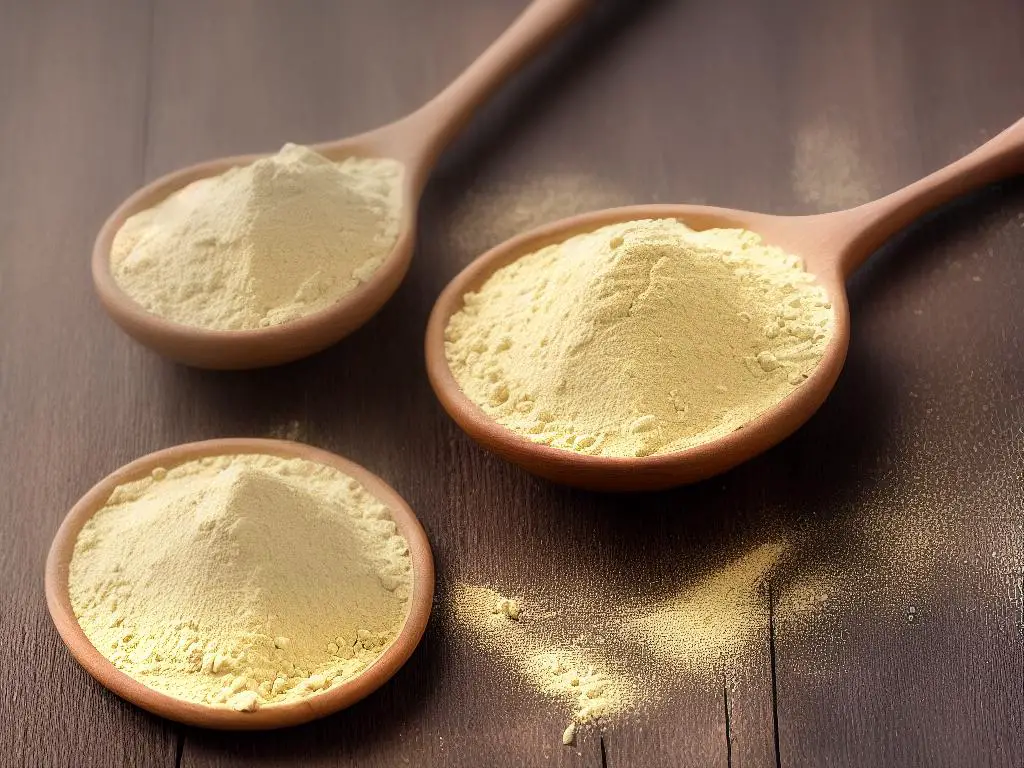
Properties of Arrowroot Powder
Introduction:
Arrowroot powder, also known as arrowroot starch or flour, is a fine white and odorless powder. It is extracted from the roots of the arrowroot plant (Maranta arundinacea), native to South America. Due to its unique chemical properties and characteristics, arrowroot powder has become a popular ingredient in baking, offering a range of benefits over traditional flour.
1. Gluten-Free:
Arrowroot powder is naturally gluten-free, making it an excellent alternative for individuals with gluten sensitivities or celiac disease. Gluten is a protein found in wheat, barley, and rye, and it can cause digestive issues for those who are intolerant. Baking with arrowroot powder allows people with dietary restrictions to enjoy baked goods without the worry of triggering their symptoms.
2. High Starch Content:
Arrowroot powder has a high starch content, which provides excellent thickening properties in baking. The unique starch composition allows it to thicken at lower temperatures and be more resistant to acidic ingredients, such as vinegar or citrus. This characteristic makes it a great choice for various baked goods, sauces, and puddings.
3. Neutral Flavor Profile:
As arrowroot powder has a neutral flavor profile, it’s an ideal thickening agent for various recipes, as it does not affect the final taste. This is particularly advantageous in baking, where the natural flavors of fruits, chocolates, or other ingredients should be the main focus.
4. Improved Texture:
Baking with arrowroot powder can result in lighter, fluffier, and more delicate textures in baked goods. It has a finer texture than other starches, which can help prevent a heavy or dense final product. Additionally, arrowroot powder’s moisture-absorbing properties help baked goods retain their moistness and prevent them from becoming too dry.
5. Quick Cooking Times:
Due to its high starch content, arrowroot powder has gelatinization properties. This gel-like consistency occurs when arrowroot powder is mixed with water and subjected to heat. The gelatinization process can help set and stabilize ingredients, resulting in a more appealing texture with quicker cooking times. This is particularly useful in pie fillings, fruit sauces, and custards.
6. Freeze-Thaw Stable:
Arrowroot powder has great freeze-thaw stability, which means that it maintains its properties even when frozen and thawed. This is helpful in baking recipes that require freezing, as it can help prevent the texture from breaking down or becoming watery when thawed.
In conclusion:
Arrowroot powder’s chemical properties and unique characteristics make it a versatile and valuable ingredient in baking. Its gluten-free nature, high starch content, neutral flavor profile, improved texture, quick cooking times, and freeze-thaw stability allow for the creation of a wide range of delicious and allergy-friendly baked goods. Next time you’re looking for a baking ingredient with distinct advantages, consider incorporating arrowroot powder into your recipes.

Arrowroot vs. Other Starches
Arrowroot powder, cornstarch, and potato starch are three common starches used in baking to thicken sauces, bind ingredients, and provide structure to various baked goods. Each of these starches has its own unique properties, advantages, and applications. In this guide, we will compare these three starches and explain their respective applications in baking.
1. Arrowroot Powder:
- Derived from the arrowroot plant, this fine white powder is gluten-free and has a neutral taste.
- It is an excellent thickener in sauces, fruit glazes, soups, and stews.
- Arrowroot powder is quite stable at high temperatures and acidic environments, making it suitable for recipes that require prolonged cooking or exposure to acidic ingredients.
- It provides a smooth and glossy finish to recipes, giving them an appealing look.
- Arrowroot powder can be used as a substitute for other starches in a 1:1 ratio. However, it may not provide the same exact texture and appearance as the original starch.
Applications: As a thickener, arrowroot powder can be used in fruit pies, puddings, custards, and gravies. It can also be used as a binder in gluten-free baking, such as in cookies and cakes.
2. Cornstarch:
- A common thickening agent derived from corn, cornstarch is also gluten-free but has a slightly more noticeable taste compared to arrowroot powder.
- It is best suited for thickening sauces, gravies, and desserts.
- Cornstarch has a high heat tolerance but can break down in acidic environments, making it less suitable for recipes with acidic ingredients (like tomatoes or lemon juice).
- It imparts a matte, cloudy finish to recipes, which can be less appealing in some cases.
Applications: Cornstarch can be used as a thickener in a variety of recipes, including fruit pies, cream-based sauces, gravies, and custards. It can also be combined with other gluten-free flours to create a soft and tender texture in baked goods like cookies and cakes.
3. Potato Starch:
- Made from potatoes, this gluten-free starch has a stronger thickening power compared to arrowroot and cornstarch.
- It is best used in recipes that require a thick, “gel-like” consistency like puddings and custards.
- Potato starch has a moderate heat tolerance and does not handle acidic ingredients very well.
- It provides a clear, shiny finish to recipes, similar to arrowroot powder.
Applications: Potato starch can be used as a thickener in puddings, custards, and some sauces. It can also be used as a binder in gluten-free baking to improve the texture and structure of recipes like pancakes, muffins, and bread.
In conclusion, arrowroot powder, cornstarch, and potato starch each play a vital role in the world of baking. While they can often be used interchangeably in recipes, understanding their unique properties and applications can help you achieve the desired results in your baking endeavors. Experiment with these three starches in your recipes, and you’ll become a more versatile and confident baker.
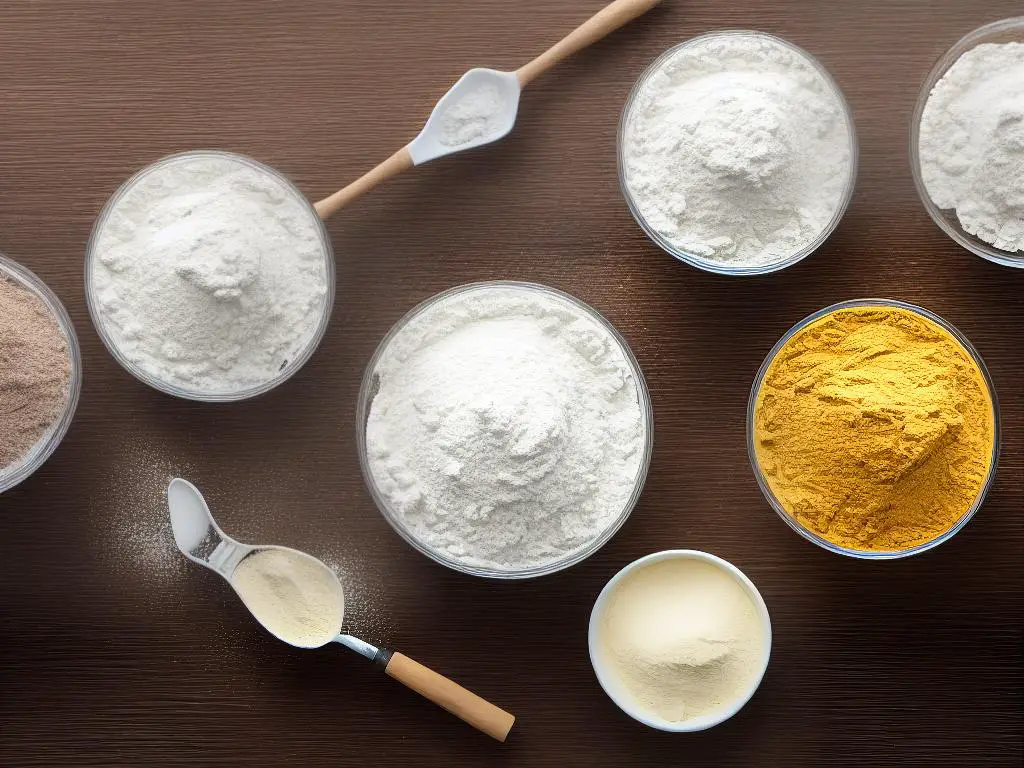
Using Arrowroot as a Thickening Agent
Using arrowroot powder in baking is an excellent way to create thick and silky textures in sauces, gravies, and pie fillings. Arrowroot powder is a starch extracted from the arrowroot plant, which helps thicken liquids without altering their color or taste. It is a popular alternative to cornstarch or flour because it is gluten-free and creates a smooth, shiny consistency. To use arrowroot as a thickening agent, follow these simple steps:
-
- Measure the arrowroot powder: The general rule of thumb is to use 1 teaspoon of arrowroot powder for every 1 cup of liquid that needs thickening. For example, if you are making a sauce with 2 cups of liquid, you will need 2 teaspoons of arrowroot powder.
-
- Create a slurry: Before adding arrowroot powder to your sauce or gravy, you must first create a slurry. To do this, mix a small amount of cool water (or liquid from your recipe) with the arrowroot powder. Stir until it forms a smooth, lump-free paste. The ratio should be about 1:1, meaning 1 teaspoon of arrowroot powder to 1 teaspoon of water or liquid. This process helps ensure that the arrowroot powder is evenly distributed and prevents clumping.
-
- Heat the liquid: Bring the sauce, gravy, or pie filling to a simmer over medium heat. Make sure it is not boiling, as arrowroot powder loses its thickening power at high temperatures.
-
- Add the slurry: Slowly pour the arrowroot slurry into the simmering liquid while stirring constantly. This will help the arrowroot powder dissolve evenly and prevent lumps from forming.
-
- Continue stirring and cooking: Keep stirring the sauce or gravy until it reaches the desired consistency, which usually takes about 1-2 minutes. If you’re making a pie filling, continue cooking until it is thick and holds together well. Be patient, as the thickening process may take a few minutes to become apparent.
-
- Remove from heat: Once the desired consistency is achieved, remove your sauce, gravy, or pie filling from the heat. Arrowroot powder thickens quickly, so do not overcook it.
- Cool and serve: Allow your thickened sauce, gravy, or pie filling to cool slightly before serving. Keep in mind that the mixture may continue to thicken as it cools.
Tips and Tricks for Using Arrowroot as a Thickening Agent:
- Do not use arrowroot powder with dairy-based sauces or gravies, as it may create a slimy texture.
- Be cautious of over-thickening, as arrowroot can give a slightly gummy texture if used excessively.
- Arrowroot thickening is best for clear sauces and gravies, as it does not create the cloudy appearance that cornstarch or flour can.
- Arrowroot powder is sensitive to acidic ingredients, so it might not thicken as well in recipes with high acidity. If using with acidic ingredients, you may need to use a bit more arrowroot powder to achieve the desired thickness.
- Keep in mind that freezing and reheating arrowroot-thickened sauces or gravies may cause them to lose their thickening properties. If possible, prepare arrowroot-thickened mixtures just before serving.
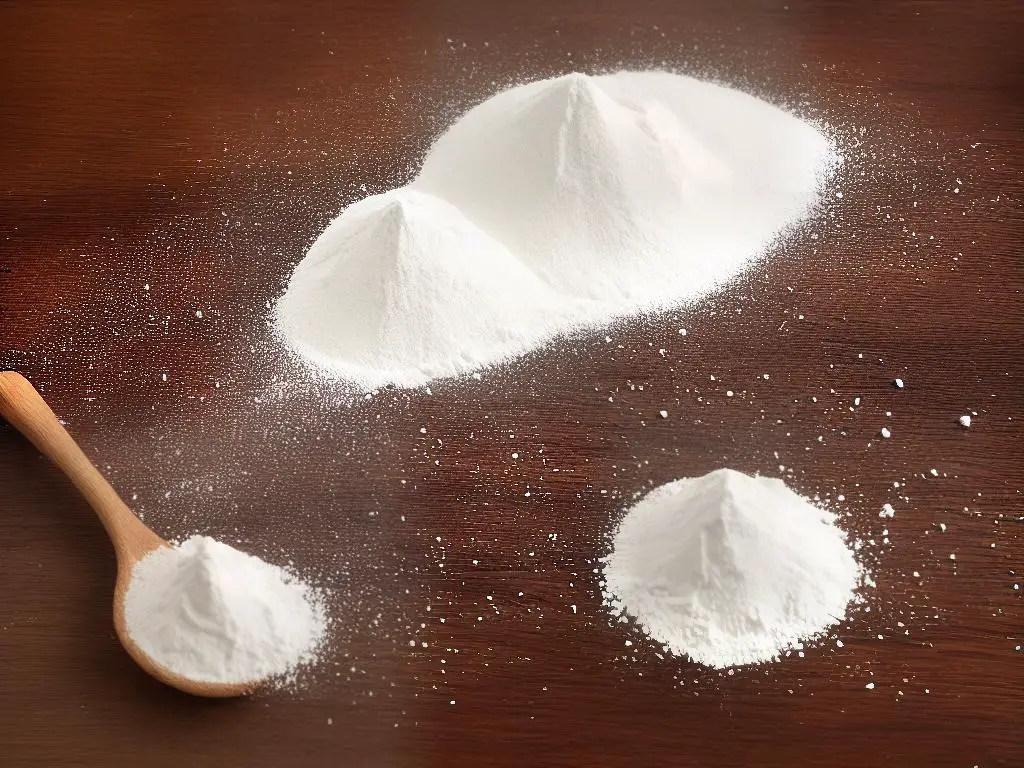
Arrowroot in Gluten-Free Baking
Arrowroot powder is an excellent gluten-free ingredient used in baking for improving the texture and structure of baked goods. Derived from the arrowroot plant, this powder acts as a thickening agent and binder, making it an ideal substitute for cornstarch and other gluten-containing flours. Its neutral flavor profile and clear consistency make it even more versatile in different recipes. In this guide, you will learn how to incorporate arrowroot powder into your gluten-free baking for delicious and perfectly textured results.When converting a traditional baking recipe to a gluten-free version, you will typically replace wheat flour with a mixture of various gluten-free flours and starches, one of which can be arrowroot powder. Generally, you can substitute up to 25% of the total gluten-free flour blend with arrowroot powder to achieve a desirable texture.To achieve the best results in texture and structure, it is essential to use a combination of gluten-free flours and starches. A basic blend includes:- 2 cups of rice flour (white or brown)- 1/2 cup of arrowroot powder- 1/2 cup of potato starch- 1/4 cup of tapioca starch You can adjust and experiment with the ratios of each flour and starch to suit your preference and the specific recipe you are making. For example, if you desire a lighter and softer texture in cakes or cookies, you may increase the proportion of arrowroot powder.To obtain a smooth, lump-free texture, it is necessary to whisk your dry ingredients well. In a separate mixing bowl, combine your gluten-free flour mix, including arrowroot powder, with other dry ingredients such as baking soda, baking powder, salt, and xanthan gum (if required). Whisk until evenly distributed.When the dry ingredients are well combined, slowly incorporate the wet ingredients into the mixture (eggs, oil, milk, etc.). Gently fold the wet and dry ingredients using a spatula or wooden spoon until a uniform batter or dough is formed. Be careful not to overmix, as this can lead to a tougher texture in the finished product.Once your batter or dough is prepared, follow the specific recipe’s baking instructions regarding temperature and time. Keep in mind that gluten-free batters and doughs may have a different consistency than their gluten counterparts. Therefore, it is essential to use visual cues and rely on a toothpick test to ensure your baked goods are cooked thoroughly.Gluten-free baked goods may have a more delicate structure compared to those with gluten, so it is crucial to allow them to cool properly before cutting or handling. Once cool, your delicious arrowroot enhanced gluten-free bake is ready to be enjoyed!
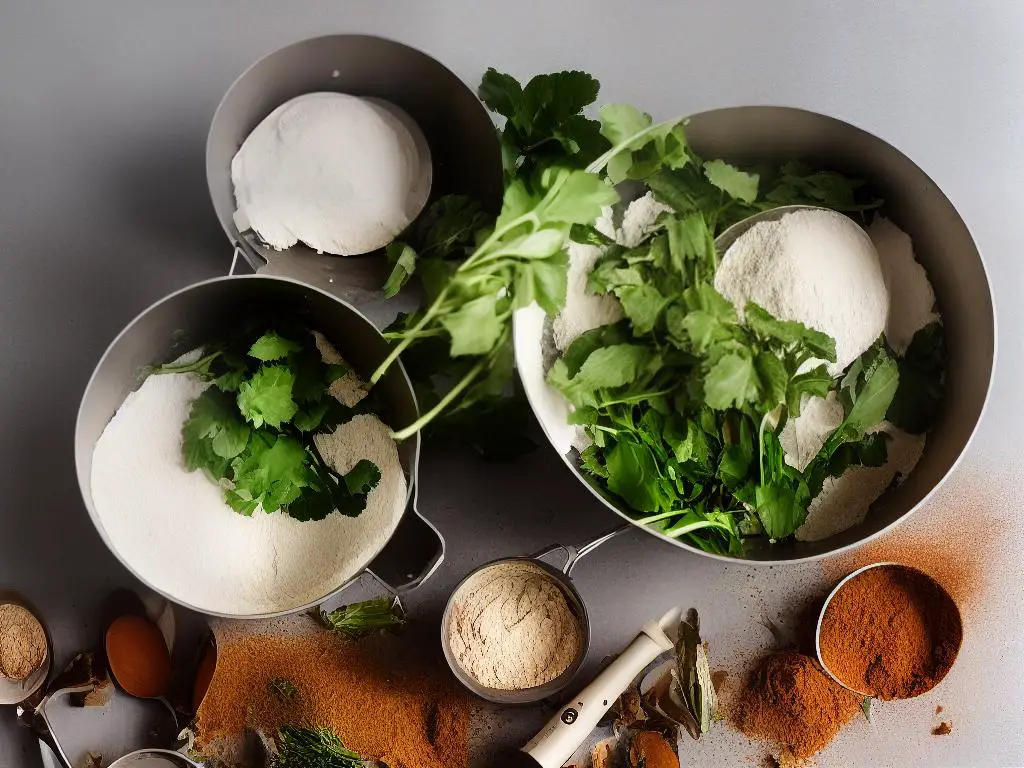
Arrowroot in Vegan Baking
Introduction
Arrowroot powder, also known as arrowroot flour or starch, is a gluten-free, grain-free, and vegan-friendly alternative to eggs in baked goods. Made from the arrowroot plant’s rhizomes, this versatile powder can help improve the texture of your baked goods and act as a binding agent, similar to eggs. In this guide, we will explore how to use arrowroot powder in vegan baking and provide some simple recipes for you to try!
Step 1: Gather Your Ingredients
Before you begin, make sure you have arrowroot powder on hand. You can find it at your local health food store or in the gluten-free section of your grocery store. Additionally, gather all other ingredients required for your desired recipe.
Step 2: Prepare Arrowroot Mixture
Arrowroot powder is typically used to replace eggs in a recipe. To create an egg substitute, simply mix 2 tablespoons of arrowroot powder with 3 tablespoons of water for each egg you want to replace in your recipe. Whisk the mixture well until it reaches a smooth consistency without any lumps.
Step 3: Add Arrowroot Mixture to Your Recipe
Once your arrowroot mixture is prepared, slowly incorporate it into your recipe. To ensure even distribution, it’s a good idea to mix it in with the wet ingredients first, before combining with the dry ingredients. Be sure to mix well to avoid any lumps in your batter or dough.
Step 4: Adjust Baking Time and Temperature
Arrowroot powder can sometimes cause baked goods to cook more quickly than those using eggs. To compensate for this, you may need to reduce the temperature of your oven by 25°F and check for doneness several minutes earlier than the recipe suggests. Keep an eye on your baked goods to avoid over-baking and achieve the desired texture.
Step 5: Enjoy Your Vegan Baked Creations
Arrowroot powder should provide a similar texture and binding quality as eggs in your baked goods, but keep in mind it may affect the final results slightly. Be patient and be prepared to make small adjustments to your recipe to achieve the perfect vegan baked goods!
Recipes to Try:
1. Vegan Chocolate Chip Cookies
A recipe for vegan chocolate chip cookies using arrowroot powder as a substitute for eggs.
2. Vegan Banana Bread
A recipe for vegan banana bread using arrowroot powder as a substitute for eggs.
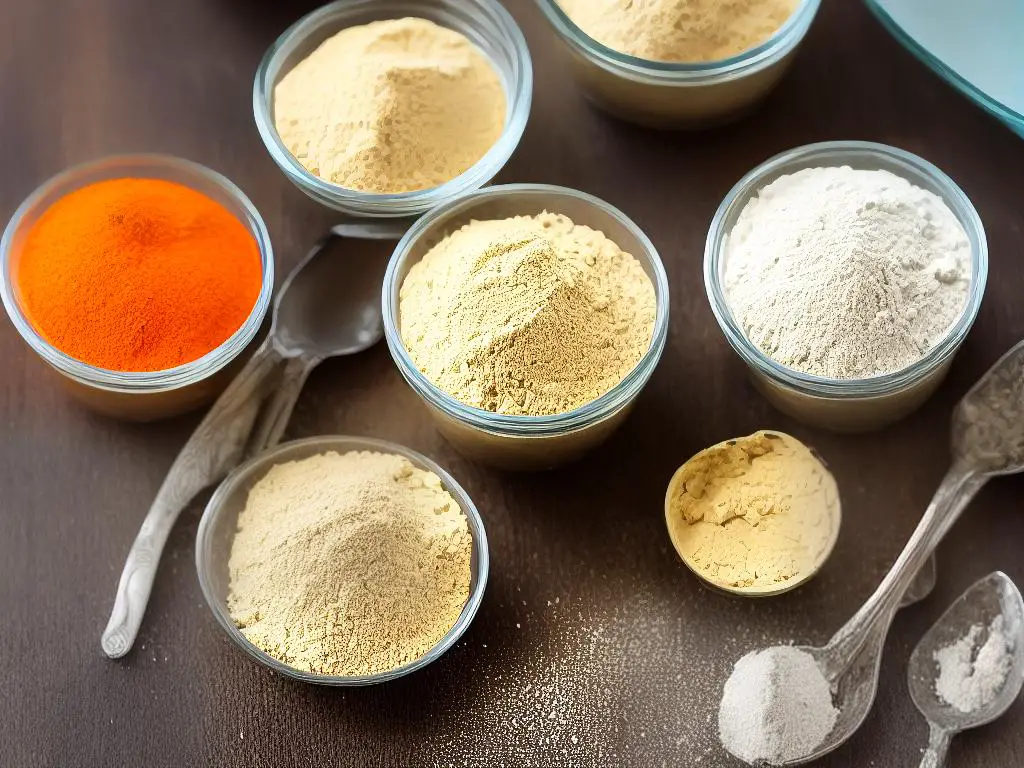
Advanced Techniques with Arrowroot
Arrowroot powder is used as a natural thickening agent in baking and has a few advanced techniques that can be used with it.The first technique is to make your own baking powder using arrowroot powder, cream of tartar, and baking soda.The second technique is to use arrowroot powder as a replacement for cornstarch or flour, especially for people with dietary restrictions.The third technique is to use arrowroot powder to thicken fruit fillings and is prepared by mixing the arrowroot powder in one tablespoon cold water.The fourth technique is to use arrowroot powder in gluten-free baking, as it can be combined with other gluten-free flours to increase moisture and improve texture.The fifth technique is to use arrowroot powder in candy-making, for example, in making marshmallows. It can act as a binding agent and help with the consistency of the final product.It’s essential to keep temperature and time in mind when incorporating arrowroot powder into baking and candy-making as too much heat or prolonged cooking may result in the loss of its thickening properties.
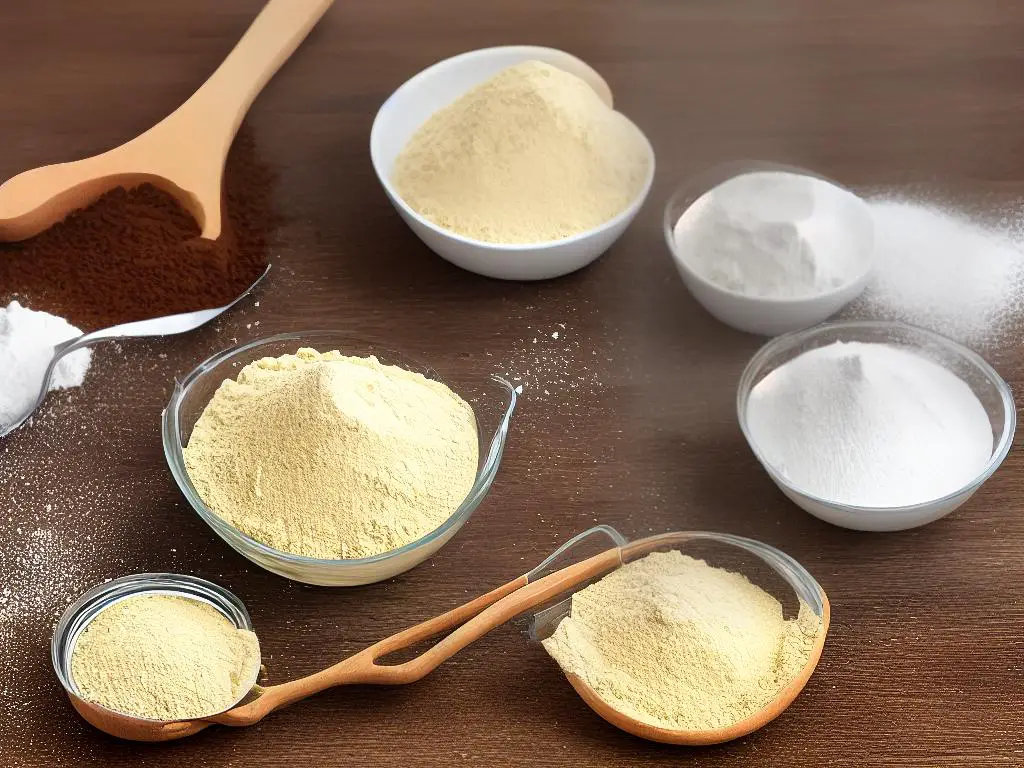
Arrowroot Powder-based Recipes
Arrowroot powder is a gluten-free, grain-free, and vegan-friendly starch that is derived from the roots of the arrowroot plant. It is often used as a thickening agent in sauces, soups, and desserts. However, it can also be used in baking to replace cornstarch or flour, making it an excellent option for individuals with dietary restrictions. Here are some delicious arrowroot powder-based recipes to try at home:1. Vegan Chocolate Chip Cookies with Arrowroot Powder
Ingredients:
– 1 cup almond flour
– 1/4 cup arrowroot powder
– 1/4 teaspoon salt
– 1/4 teaspoon baking soda
– 3 tablespoons coconut oil, melted
– 1/4 cup maple syrup
– 2 teaspoons vanilla extract
– 1/2 cup vegan chocolate chips
Instructions:
1. Preheat your oven to 350°F (177°C). Line a baking sheet with parchment paper.
2. In a large bowl, whisk together almond flour, arrowroot powder, salt, and baking soda.
3. In a separate small bowl, combine melted coconut oil, maple syrup, and vanilla extract.
4. Add the wet ingredients to the dry ingredients, mixing until a dough forms.
5. Fold in the vegan chocolate chips.
6. Use a tablespoon to place dough onto the prepared baking sheet, spacing each cookie about two inches apart.
7. Bake for 10 to 12 minutes or until the edges are golden brown.
8. Allow the cookies to cool on the baking sheet for 5 minutes before transferring to a wire rack to cool completely.
2. Gluten-free Blueberry Muffins with Arrowroot Powder
Ingredients:
– 1 cup almond flour
– 1/4 cup arrowroot powder
– 1/4 cup coconut sugar
– 2 teaspoons baking powder
– 1/2 teaspoon salt
– 2 large eggs
– 1/4 cup unsweetened almond milk
– 1/4 cup coconut oil, melted
– 1 teaspoon vanilla extract
– 1 cup fresh blueberries
Instructions:
1. Preheat your oven to 350°F (177°C). Line a 12-cup muffin pan with paper liners.
2. In a large bowl, whisk together almond flour, arrowroot powder, coconut sugar, baking powder, and salt.
3. In a separate medium bowl, whisk together eggs, almond milk, melted coconut oil, and vanilla extract.
4. Pour the wet ingredients into the dry ingredients, stirring until just combined.
5. Gently fold in the fresh blueberries.
6. Fill each muffin cup about 3/4 full with batter.
7. Bake for 25 to 30 minutes, or until a toothpick inserted into the center of a muffin comes out clean.
8. Allow the muffins to cool in the pan for 10 minutes before removing and placing them on a wire rack to cool completely.
3. Arrowroot Powder-based Flatbread (gluten-free)
Ingredients:
– 1 cup tapioca flour
– 1/4 cup arrowroot powder
– 1/4 teaspoon salt
– 1 teaspoon olive oil
– 2/3 cup water
Instructions:
1. In a medium mixing bowl, whisk together tapioca flour, arrowroot powder, and salt.
2. Add olive oil and water, stirring until a smooth batter forms.
3. Heat a non-stick skillet over medium heat.
4. Pour about 1/4 cup of batter into the skillet, quickly tilting the pan to evenly distribute the batter.
5. Cook for 2-3 minutes until the edges begin to curl and the flatbread is easy to flip.
6. Flip the flatbread and cook for an additional 1-2 minutes on the other side.
7. Repeat with the remaining batter, making sure to grease the skillet as needed.
8. Serve the arrowroot powder-based flatbread with your favorite dip, spread, or use as a wrap.

Now that you’ve explored the many facets of arrowroot powder and its applications in baking, you’re equipped with the knowledge and skills to bring your culinary creations to new heights. From gluten-free and vegan masterpieces to advanced techniques and delicious recipes, arrowroot powder is a valuable ally in your baking adventures. So, get ready to experiment, create, and indulge in the versatile and impressive world of arrowroot powder.
